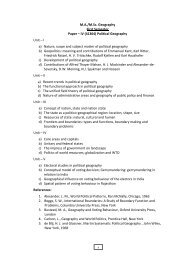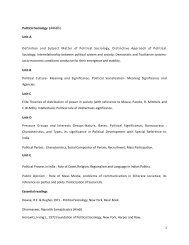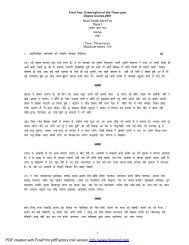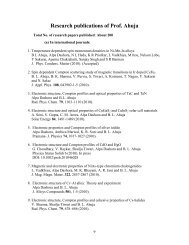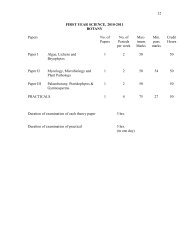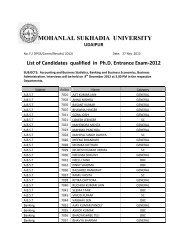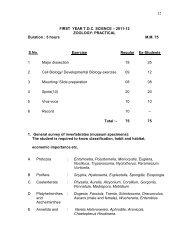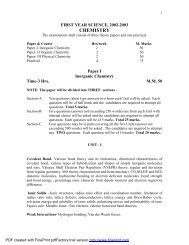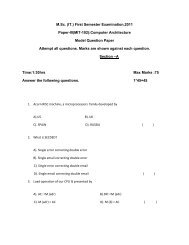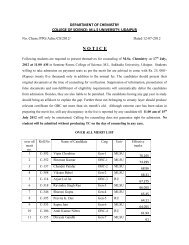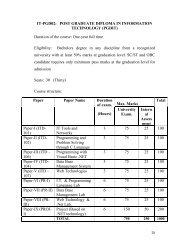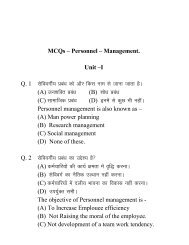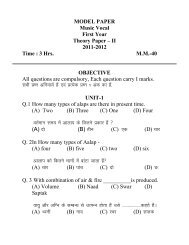12 3.5 Pharmacognosy-I 1. Introduction, development, present ...
12 3.5 Pharmacognosy-I 1. Introduction, development, present ...
12 3.5 Pharmacognosy-I 1. Introduction, development, present ...
You also want an ePaper? Increase the reach of your titles
YUMPU automatically turns print PDFs into web optimized ePapers that Google loves.
<strong>3.5</strong> <strong>Pharmacognosy</strong>-I<br />
<strong>1.</strong> <strong>Introduction</strong>, <strong>development</strong>, <strong>present</strong> status and future scope of pharmacognosy,<br />
study of various systems of classification of crude drugs.<br />
2. Systematic study of crude drugs including English, Indian Synonyms, Biological<br />
and Geographical sources (by macroscopy, sensory and microscopic of the drugs<br />
underlined) chemical constituents, chemical and microchemical tests, uses,<br />
adulterstion and evaluation of the following drugs;<br />
(i) Drugs containing carbohydrates: Starch, Honey, Guargum, Sodium<br />
alginate, Agar, Linseed, Ispaghula, Bael, Acacia, Tragacanth, Sterculia,<br />
Katira, Pectin and Lactose.<br />
(ii) Fixed oils, Fats and Waxes: Olive oil, Caster oil, Sesame oil, Neem oil,<br />
Arachis oil, Chalmoogra oil, Theobroma, Lard, Suet, Shark liver oil,<br />
Lanolin, Beeswax, Spermaceti, Jujuba wax.<br />
(iii) Drugs containing Volatile Oil: Mentha, Coriander, Cinnamon, Cassia,<br />
Lemon Peel, Lemongrass, Citronella, Caraway, Cumin, Dill, Spearmint,<br />
Clove, Fennel, Nutmeg, Acorus calamus, Eucalyptus, Chenopodium,<br />
Cardamom, Valerian, Pyrethum.<br />
(iv) Drugs containing Resin: Benzoin, Tolu Balsam, Colophony, Asafoetida,<br />
Jalap, Kaladana, Ginger, Colocynth, Capsicum, Turmeric, Cannabis,<br />
Podophyllum.<br />
(v) Drugs containing Glycosides: Senna, Aloe, Rhubarb, Cascara, Digitalis,<br />
Strophanthus, scilla, Thevetia, Dioscorea, Glycyrrhiza, Psorelea, Gentian,<br />
Picorrhiza, Chirata, Quassia, Catechu, Myrobalan, Ammi majus, Quillaia.<br />
(vi) Drugs containing alkaloids: Lobelia, Nicotiana, Belladonna, Hyoscyamus,<br />
Datura, Withania, Coca, Cinchona, Ipecac, Curare, Opium, Nux vomica,<br />
Ergot, Rauwolfia, Catharanthus, Aconite, Veratrum, Ephedra, colchicum.<br />
(vii) Miscellaneous Drugs: Gelatin, Jatamansi, Malefern and Sausera.<br />
3. Study of biological sources, Chemical tests, microscopic features of commercial<br />
fibres and earths used as surgical dressing and filtering media:<br />
(i) Cellulose and its derivatives: Cotton wool, Oxidised cotton, Methyl<br />
Cellulose, Carboxy methyl cellulose, cellulose wadding.<br />
(ii) Vegetable, Animal and Synthetic fibres: Jute, Wool, Silk, Nylon,<br />
Terylene, Polythene.<br />
(iii) Inorganic Pharmaceutical Aids: Talc, Diatomite, Asbestos, Fuller’s earths,<br />
Bentonite.<br />
<strong>12</strong>
4. Evaluation: Identity, Purity and quality of the drug plants by organoleptic,<br />
microscopic, physical, chemical and biological methods.<br />
5. Variability of drug constituents due to exogenous and endogenous factors, like<br />
altitude, temperature, rainfall, light, propagation by seeds, vegetative means,<br />
selection, mutation, hybridization and polyploidy.<br />
6. Collection of medicinal plants: Effect of various factors like reason, time, age of<br />
plants etc drying of plants, hazards like infestation with spores of<br />
microorganisms. Drug deterioration by factors like moisture etc.<br />
7. Chromatography: Various chromatographic methods covering column, paper, thin<br />
layer and gas chromatography.<br />
PRACTICALS<br />
<strong>1.</strong> Identification by morphological and sensory character of drugs mentioned in<br />
theory.<br />
2. Detailed study under microscopy of whole and powdered drugs and chemical tests<br />
of drugs underlined in theory.<br />
3. Identification of unorganized drugs included in theory by chemical tests.<br />
4. Study of fibres by macroscopical, microscopical and chemical tests.<br />
5. Practical exercise on chromatography:<br />
(i) TLC of alkaloidal extracts of the following drugs- ergot, datura, cinchona,<br />
opium, ipecac, nux vomica and Rauwolfia.<br />
(ii) TLC of volatile oils of Dill, Lemongrass, Mentha and Eucalyptus.<br />
6. Quantitative microscopy- Determination of stomatal index, palisade ratio,<br />
veinislet number etc.<br />
Books Recommended:<br />
<strong>1.</strong> <strong>Pharmacognosy</strong> (8 th ed.) 1981, V.E. Tylor, L.R. Brady and J.E. Robbers, Pub.<br />
Learned Febiger, Philadelphia, USA.<br />
2. <strong>Pharmacognosy</strong> (<strong>12</strong> th ed.) GE Trease and W.C. Evans Pub. Baillers Tindall,<br />
London.<br />
3. Surgical dressing and wound healing Ed. K.J. Harkiss, Bradford University Press,<br />
UK.<br />
4. Cultivation and utilization of Aromatic plants EDA tal and B.N. Kapoor Pub.<br />
Council of Scientific Industrial Research (CSIR), New Delhi.<br />
5. Powdered Vegetable drugs, BP Jackson and DW Snewden, Pub. J.A. Churchill.<br />
6. Thin Layer Chromatography, Egon Stahl Pub. Springer Verlag.<br />
7. Quantitative paper and Thin Layer Chromatography, E.J. Shellard Pub. Academic<br />
Press.<br />
8. The organic constituents of higher plants, Trevor Bargress Pub. Co.<br />
9. <strong>Pharmacognosy</strong> T.E. Wallis, Pub. J.A. Churchill.<br />
13



